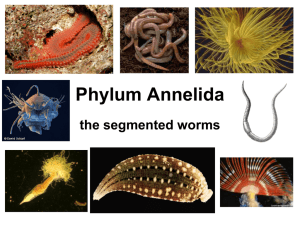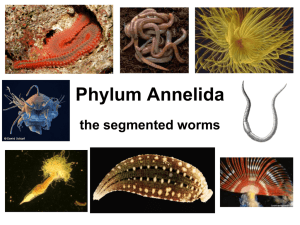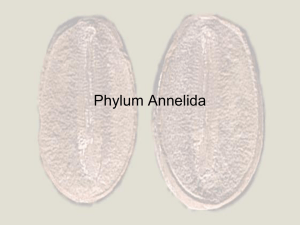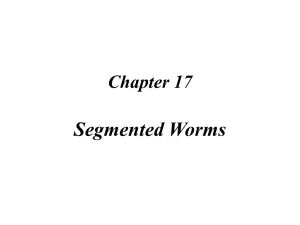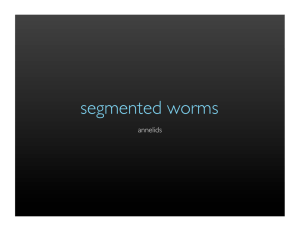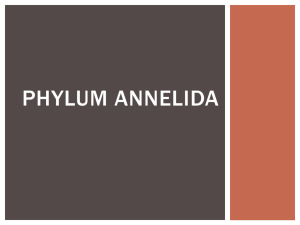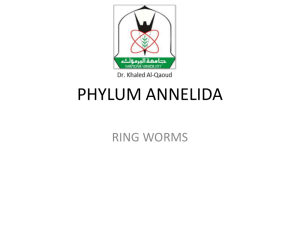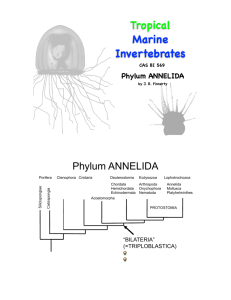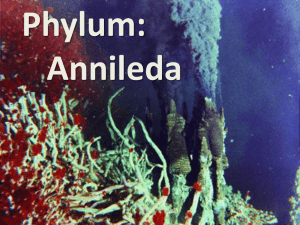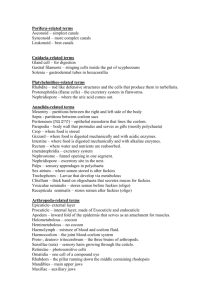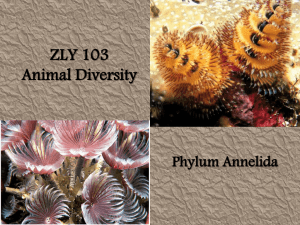Class Polychaeta
advertisement
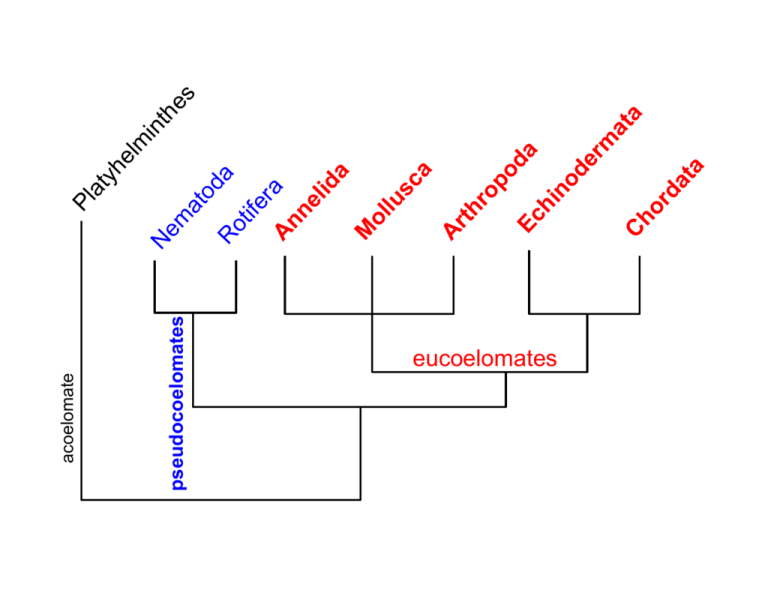
pseudocoelomates acoelomate eucoelomates em at o da el m in th es ot ife ra An ne lid a M ol lu sc a Ar th ro po da Ec hi no de rm at a Ch or da ta R N Pl at yh pseudocoelomates acoelomates he lm hr o eucoelomates po da de Ch rma ta or da ta Ec hi no Ar t M ol lu sc a id a in th es el er a An n Ro tif Ne m at od a Pl at y protostomes deuterostomes Protostome: blastopore becomes the mouth and the anus forms secondarily Future anus blastopore archenteron (primitive gut) mouth Deuterostome: blastopore becomes the anus and the mouth forms secondarily Future mouth blastopore archenteron (primitive gut) anus Protostome: spiral Cleavage 2 cells 4 cells 8 cells Blastomeres divide at an oblique angle to one another, so that each lies in the furrow created by the cells beneath them Deuterostome: Radial Cleavage 2 cells 4 cells 8 cells Blastomeres divide in a symmetrical fashion, producing layers of cells directly on top of one another Protostome: mosaic Development one blastomere is removed development is arrested 4-cell stage Deuterostome: regulative Development One blastomere is removed Development continues Development continues 4-cell stage Æ each blastomere is capable of regulating its development even when separated from the others Protosome coelom formation: schizocoely ectoderm endoderm mesoderm coelom forms from a split in the mesoderm Deuterostome coelom formation: enterocoely early mesodermal pouch ectoderm endoderm mesoderm coelom forms from an outpocketing of the archenteron Protostome vs Deuterostome Protostome • blastopore becomes the mouth Deuterostome • blastopore becomes the anus • radial / indeterminate cleavage • spiral / determinate cleavage • regulative development • mosaic development • enterocoely • schizocoely (Echinodermata, Chordata) (Annelida, Arthropoda, Mollusca, Bryozoa*) Phylum Annelida the segmented worms Annelida Characteristics Triploblastic Organ level of organization Bilateral Symmetry Cephalization Annelida Characteristics Eucoelomate Have a “true” body cavity that is completely surrounded by mesoderm gut endoderm endoderm gut gut Annelid Characteristics the coelom ectoderm the gut • is a closed, fluid filled cavity that surrounds • the fluid within acts as a circulatory system • mesodermal membranes (mesenteries) suspend organs in the coelom Annelida Characteristics Protostome development • blastopore becomes the mouth • spiral / determinate cleavage • mosaic development • schizocoely Annelida Characteristics Body Plan prostomium Metamerism:The body is made metameres pygidium up of serially repeating, coordinated segments called metameres that are separated from one another by septa. septa Each metamere contains sets of repeating organs (e.g. gut, blood vessels, nerve cord, excretory organs) How areproglottids different from true metameres? 1. Proglottids are not coordinated. 2. Proglottids only contain reproductive organs. Annelid Characteristics Feeding and Digestion • Free living and parasitic species Annelid Characteristics Digestive System • complete • regional specialization intestine mouth esophagus pharynx crop gizzard Annelida Characteristics Skeletal System • fluid in coelom acts as a hydrostatic skeleton Annelida Characteristics Locomotion • both longitudinal and circular muscles • most have setae (chitonous bristles secreted by the epidermis) that aid in locomotion and burrowing setae epidermis muscles Annelida Characteristics Nervous system • 2 cerebral ganglia • a ventral nerve cord with 2 ganglia per metamere. • In some species, sensory organs such as eyes, palps, and tentacles have arisen segmental nerve cerebral ganglion mouth ventral nerve cord Annelid Characteristics Gas exchange • mainly by diffusion • Some Annelids have specialized structures for gas exchange (e.g. parapodia, gills) Annelid Characteristics Circulatory System • closed circulatory system composed of blood vessels (some of which are contractile and act as “hearts”) • some circulation is also accomplished by the coelomic fluid subintestinal blood vessel subneural blood vessel dorsal blood vessel subesophageal blood vessel ventral hearts blood vessel Annelid Characteristics Excretion/ osmoregulation • excretion is accomplished by organs called nephridia (singular nephridium) •there are usually 2 nephridia per metamere tubules and capillaries bladder nephrostome nephridiopores In nephrostome (from coelomic fluid) narrow tube middle tube wide tube protein, water, urea, NH3+, Cluric acid urea NH3+ salts salts protein K+, Na+, Clwater bladder (out nephridiopore) water, urea, uric acid, NH3+, Cl- K+, Na+, Annelid Characteristics Reproduction • sexual: monoecious or dioecious •Most species have a trochophore larva Phylum Annelida Class Polychaeta Class Oligochaeta Class Hirudinea Class Polychaeta Class Polychaeta • all marine • this class contains 2/3 of all known Annelids (approx. 10, 000 species) • have a well developed head with specialized sense organs Class Polychaeta • have many setae (chitonous bristles secreted by the epidermis) (Poly = many, chaeta= setae) • these setae are arranged in bundles on paddlelike appendages called parapodia setae Class Polychaeta notopodium neurodium muscles The parapodia function in gas exchange, locomotion, and feeding. acicula setae capillaries parapodium Lateral blood vessels Class Polychaeta Tagmatization (tagmosis) • the fusion and specialization of formerly metameric segments Class Polychaeta Many are filter-feeders with specialized structures Class Polychaeta Many are predatory with specialized structures Class Polychaeta Many construct their own homes out of CaCO3 or sand debris and mucous Class Polychaeta Reproduction • usually dioecious • no permanent sex organs; gametes are shed into coelom • fertilization is usually external • indirect development Æ trocophore larvae Class Polychaeta Epitoky atoke epitoke Ecology • Polychaetes often have effective defense strategies: • some have tubes to hide in • some have vicious jaws • some have modified “stinging” setae a fireworm Ecology • Some Polychaetes have a mutualistic relationship with their host • for example, many scaleworms are found near, or in the mouth, of brittlestars, starfish, and sea urchins. • The scaleworm eats its host’s leftovers and with its vicious jaws, it will attack any predator trying to eat it’s host. Class Oligochaeta Class Oligochaeta • terrestrial, freshwater and marine •approx 2, 000 species • have few setae (Oligo = few, chaeta = setae) • usually feed on detritus (decaying organic matter) • have specialized digestive system to obtain the maximum amount of nutrients out of the detritus (e.g. typhlosole, gizzard, crop…) Class Oligochaeta typhlosole• infolding of the dorsal side of the intestine • increases surface area for absorption of nutrients typhlosole gut Class Oligochaeta Locomotion Circular muscle contraction Longitudinal muscle contraction Class Oligochaeta Reproduction • usually monoecious • cross-fertilize by exchanging sperm clitellum testis Ecology • Earthworms are essential soil aerators • If all the material ever moved through earthworms was piled up, the heap would rise 30miles , more than 5 times the height of Mount Everest!! • Worm Grunting: A saw or leaf spring of a pick-up stob Class Hirudinea Class Hirudinea • usually freshwater but there are some marine and terrestrial species • no septa between metameres • no setae • have 2 suckers Class Hirudinea • have an extendable proboscis for feeding Class Hirudinea • usually have a fixed number of segments (34) • each metamere consists of several annuli (think accordion) 1 metamere annuli Class Hirudinea Locomotion Lack septa between metameres, so they are incapable of moving like Oligochaetes. Instead, they use their anterior and posterior suckers to move. Class Hirudinea Reproduction • usually monoecious • cross-fertilize by exchanging sperm Ecology • Although some leeches are parasitic blood suckers (can be temporary or permanent), many are predators.
